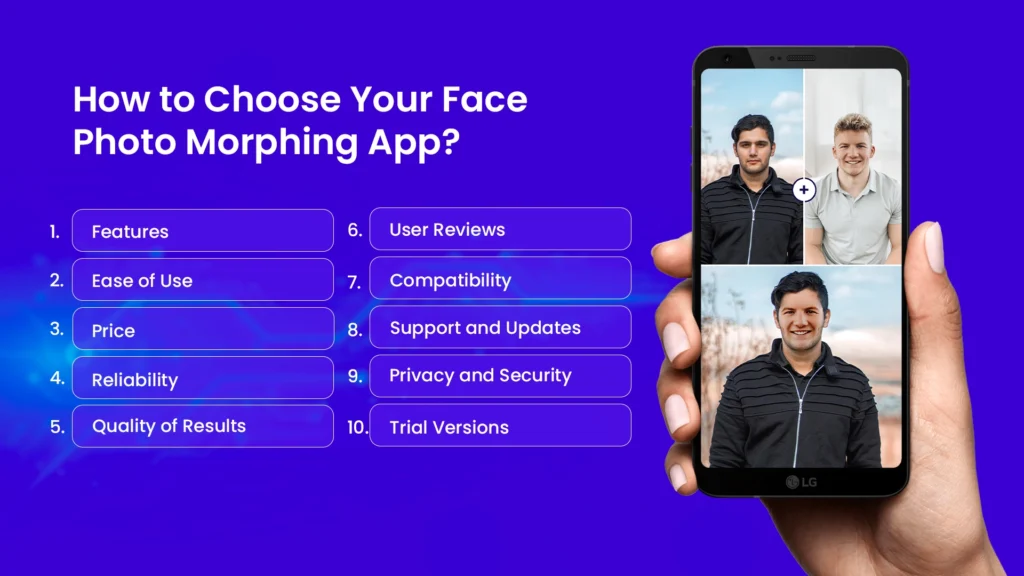Have you ever seen pictures that smoothly transform from one image to another? That’s photo morphing! It’s like digital magic, where you can blend and change one picture into another. You can do this with faces, objects, or anything you like, creating cool images, videos, and GIFs.
But how does it work, and what tools can you use to try it? We’re here to explain the exciting world of image morphing. We’ll talk about how it works, what you need to know before you start, and the software to use. Whether you’re an artist or just curious, photo morphing is a fun way to play with pictures.
Let’s dive in and discover how you can make your own morphing magic happen!
What is a Photo Morph?
Photo morphing is an advanced technique by which you can edit your face and make amazing photo morph transition images, videos, gifs, etc. It involves blending and transforming one image into another seamlessly, creating a smooth and gradual transition between two or more images. This process can be used to morph pictures of faces, objects, or any other subjects, resulting in intriguing and artistic transformations. These transformations can be used to create images, videos, GIFs, or other multimedia content.
Image morphing is versatile, finding applications in entertainment, art, scientific research, and more. You can access photo morphing online tools to experiment with photo morphing and create unique visual content.
How Does Image Morphing Work?
Image morphing is a fascinating technique that involves mixing the pixels of two images to seamlessly merge a photo of two persons. Here’s how image morphing works:

1) Selection of Source and Target Images
The first step in image morphing is to select two images: the source image and the target image. These images can be of faces, objects, or any subjects you want to morph.
2) Point or Feature Correspondence
To achieve a smooth transition between the source and target images, a set of corresponding points or features are selected on both images. These points serve as anchor points and guide the morphing process. Common features include key facial landmarks (e.g., eyes, nose, mouth) in the case of face morphing.
3) Warping
Once the corresponding points are identified, the source image is geometrically transformed to align with the positions of these points in the target image. This transformation warps the source image to match the shape and structure of the target image in the selected areas.
4) Cross-Dissolve
After warping, the pixel values of the two images are blended together using a technique called cross-dissolve. At each point along the transition, the pixel values from the source image and the target image are mixed to create an intermediate pixel value. This blending is done smoothly, creating a gradual transition.
5) Frame Generation
The morphing process is typically divided into multiple frames or steps. In each frame, the degree of blending between the source and target images is adjusted. By gradually changing this blending ratio from one frame to the next, a smooth animation is created, showing the transformation from the source to the target image over time.
6) Rendering
Once all the frames are generated, they are played in sequence to produce a morphing animation. This animation can be exported as a video, GIF, or a series of images, depending on the desired output.
This pic morphing technique is widely used in computer graphics, animation, and digital art to create captivating visual effects and transformations.
How to Choose Your Face Photo Morphing App?
When you’re searching for the right face morphing app, consider these factors, especially if you want to morph pictures online or morph two images:

1) Features
Determine what specific features you need. Are you looking for basic face morphing, or do you want additional features like face swapping, adding filters, or creating animations? Select an app that offers the features you need.
2) Ease of Use
Consider your level of expertise. Some apps are designed for beginners and offer user-friendly interfaces with intuitive controls, while others may require more technical knowledge. Select an app that matches your skill level.
3) Price
Decide on your budget for a face morphing app. Many apps have free versions with restricted features, while others need a one-time payment or subscription. Evaluate your willingness to invest in a paid app if it offers the functionalities you need.
4) Reliability
Research the app’s reputation for reliability. Look for user reviews and ratings to see if the app is known for stability or if it frequently crashes. A reliable app is essential to ensure your projects run smoothly.
5) Quality of Results
Pay attention to the quality of morphing and transformations the app can achieve. Some apps may produce more realistic results than others. Look for examples and demonstrations to assess the app’s output quality.
6) User Reviews
Read user reviews and testimonials to gain insights into other users’ experiences with the app. This can provide valuable information about its performance, ease of use, and overall satisfaction.
7) Compatibility
Ensure that the app is compatible with your device and operating system (e.g., iOS, Android, Windows, macOS). Compatibility issues can be frustrating and limit your ability to use the app effectively.
8) Support and Updates
Check if the app receives regular updates and has customer support available. Updates often include bug fixes and improvements, while good customer support can help you resolve any issues you encounter.
9) Privacy and Security
If the app requires access to your photos or other personal information, review its privacy policy to ensure your data is handled securely and according to your preferences.
10) Trial Versions
Whenever possible, try out free trial versions or demo versions of the best photo morphing app. This allows you to test the app’s capabilities and user-friendliness before making a commitment.
Ultimately, the choice of a face morphing app should align with your specific needs, budget, and level of expertise. By considering these factors, you can make an informed decision when choosing an online face-morphing tool or app to morph pictures together or perform image morphing online.
What Can You do Before Photo Morph?
Before you begin the process of photo morphing, there are several preparatory steps and considerations you can take into account, especially if you plan to, morph pictures together, or morph one image into another:
1) Image Selection: Choose the source and target images carefully. Ensure they are of good quality and represent the subjects or objects you want to morph accurately.
2) Image Resolution: Check the resolution of your images. Super-resolution images tend to produce better results in morphing, especially when morph two pictures together. Low-resolution images may result in loss of detail.
3) Image Alignment: If you intend to morph one image into another, make sure both images are properly aligned. This involves matching the perspective and positioning of the subjects in both images as closely as possible.
4) Feature Identification: If you’re morphing faces or specific features, identify key landmarks or points on both images. This will help guide the morphing process and ensure smoother transitions.
5) Backup: Always create backup copies of your original images. Photo morphing is a non-destructive process, but it’s a good practice to safeguard your original files.
6) Software or App Selection: Choose the appropriate best photo morphing software or app for your project. Depending on your requirements, select one that can effectively morph images, morph pictures together, or morph one image into another.
By taking these steps before starting your photo morphing project, you can set yourself up for a smoother and more successful morphing experience, whether you intend to morph images.4.5/5
What are the Best Image Morphing Techniques?
AI Image Morphing Techniques represent a sophisticated approach in digital image manipulation. This methodology is based on mixing the pixel of two images to merge a picture of two persons. What distinguishes this technique is its ability to merge these pixels seamlessly, resulting in a captivating and visually striking composition. In particular, Image Morphing finds significant utility in creating composite portraits of two individuals, where their features are harmoniously interwoven.
The uniqueness of this technique lies in its remarkable ability to harmoniously blend pixel data, resulting in a captivating and visually striking composition. For those seeking to morph two photos, engage in image morphing after effects, blend two faces together, or perform a picture swap face, this method offers a powerful solution. With the advancements in image morphing AI, this captivating process not only produces engaging visuals but also showcases the limitless possibilities in contemporary image editing and manipulation.
What is the Function of Morphing in Image Processing?
In the world of digital photo editing, the emergence of AI-powered image morphing online free tools has transformed the way we manipulate pictures. These AI image morphing online solutions have made it easier than ever to morph photos for free and create captivating transformations.
Imagine AI photo morphing as having a super-smart ai photo editor at your fingertips. It effortlessly changes one photo or shape into another through transitioning the pixels, lines, and features in your pictures, resulting in seamless and realistic changes from one image to another.
The best part is that you can access these image morphing online tools for free. They offer a user-friendly experience, making image morphing accessible to everyone, regardless of their budget.
Whether you’re looking to craft fun animations, smoothly blend two faces together, or experiment with cool visual effects, image morphing is a creative outlet that’s now within reach thanks to AI and free online tools. It’s like painting with pixels, and the possibilities are endless! So, don’t hesitate to explore the world of AI image morphing online and start morphing photos for free today.
Conclusion
Photo morphing ai is a captivating and versatile tool that allows for the seamless transformation of one image into another, creating captivating transitions and artistic transformations. Whether you want to morph faces, objects, or any other subjects, this process offers a versatile tool for creating images, videos, GIFs, and more.
AI photo morphing and photo morph online free tools have revolutionized the accessibility and quality of this technique. Leveraging artificial intelligence, these tools enable precise adjustments, resulting in realistic and impressive transformations. This democratizes the art of morphing, making it accessible to individuals of all skill levels.
Before embarking on a photo morphing project, it’s essential to consider factors such as image selection, resolution, alignment, and feature identification. These preparatory steps contribute to the success of your morphing endeavors, whether you want to morph two pictures together or perform AI photo morphing.
Additionally, a variety of tools and apps are available for photo morphing, each with its own set of features, ease of use, and compatibility. Choosing the right tool depends on your specific requirements and preferences, especially if you aim to morph 2 pictures together seamlessly.





























